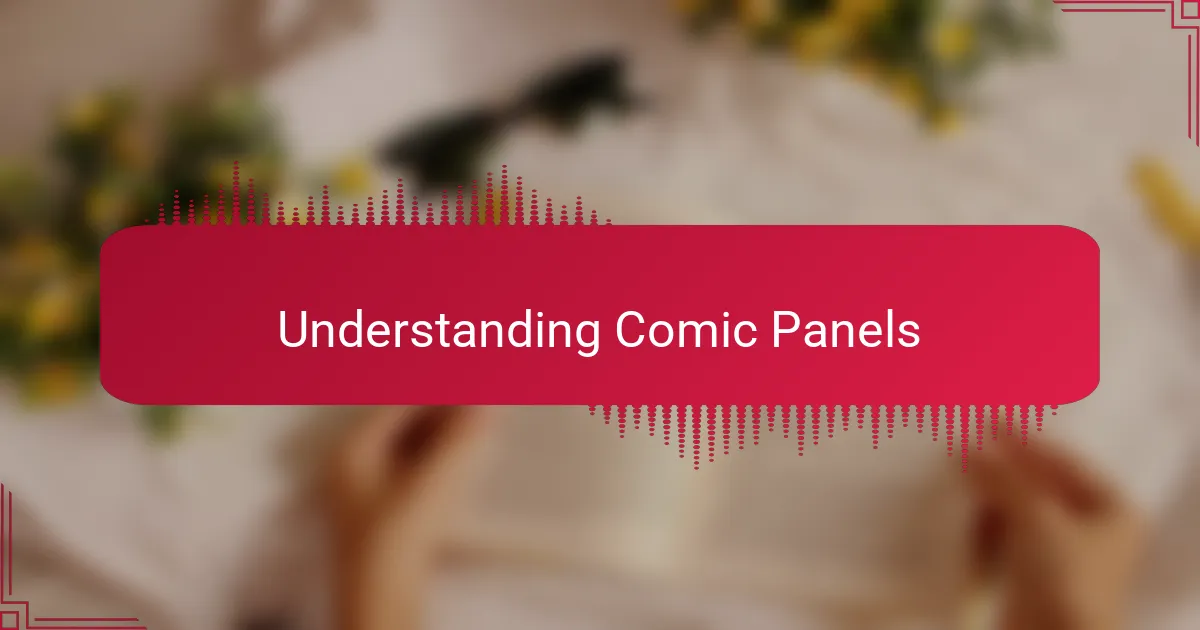Key takeaways
- Comic panels are essential for storytelling and can significantly influence reader emotions through size, shape, and character expressions.
- Visual representation of feelings in comics allows for immediate emotional impact, creating a strong connection with readers.
- Techniques such as exaggerating expressions and using color psychology enhance emotional expression in comics.
- Tools, both digital and traditional, play a crucial role in how emotions are conveyed visually in comic creation.

Understanding Comic Panels
Comic panels are the heartbeat of any comic, serving as the framework that holds your story together. Through my experience, I’ve realized that each panel can evoke a range of emotions—from joy to despair—just by the way you display characters and their surroundings. For instance, I once illustrated a moment of heartbreak using a tightly framed panel, focusing on the character’s teary eyes, which amplified the emotional impact significantly.
In my creative journey, I’ve found that playing with panel size and shape can also alter emotional perception. A cramped panel can create a sense of urgency, while a wide, open panel might evoke freedom or nostalgia. It’s fascinating how minor adjustments can shift the reader’s emotional engagement dramatically.
Here’s a quick comparison of how different elements of a comic panel can influence emotions:
| Element | Emotional Impact |
|---|---|
| Panel Size | Smaller panels can create tension; larger panels can evoke wonder. |
| Character [censured] Expressions | Subtle expressions convey depth; exaggerated ones can induce laughter or surprise. |
| Background Detail | Simplified backgrounds focus on characters’ emotions; detailed environments expand emotional context. |

Importance of Emotions in Comics
Capturing emotions in comic panels is foundational to storytelling. When readers can feel the highs and lows of the characters, they become more invested in their journeys. Personally, I’ve found that a well-drawn expression or moment of silence can speak volumes, often more than dialogue ever could.
For instance, in one of my comics, I illustrated a moment where the hero mourns a loss, using shadows and drawn tears rather than words. The impact was profound—readers shared how they felt a deep connection to the character’s sorrow. This interplay of visuals and emotions creates a powerful bond between the story and the audience.
Here’s a comparison of emotional expressions in comics versus traditional narratives:
| Comics | Traditional Narratives |
|---|---|
| Visual representation of emotions through [censured] expressions and body language | Descriptive language to convey emotional states |
| Immediate emotional impact with visual cues | Requires imagination to visualize characters’ emotions |
| Speedy conveyance of feelings in a single panel | Slower build-up through dialogue and narrative |

Techniques for Capturing Emotions
When it comes to capturing emotions in comic panels, mastering [censured] expressions can make a world of difference. I remember working on a particularly intense scene where a character faced a major loss. By exaggerating the character’s eyes and mouth, I was able to convey profound sorrow, allowing readers to connect deeply with their grief. It’s as if the eyes become windows to the soul, revealing layers of emotion that words sometimes can’t express.
Body language is equally crucial. For instance, I often illustrate characters with hunched shoulders or closed-off stances in moments of vulnerability. This visual cue speaks volumes, sometimes even more than a dialogue balloon. It’s fascinating how a slight tilt of the head or the placement of a hand can instantly evoke feelings of isolation or confidence.
Here are some techniques that can enhance emotional expression in your comics:
- Exaggerate [censured] Expressions: Use large eyes and mouths to amplify emotions.
- Utilize Color Psychology: Select colors that evoke specific feelings, such as blue for sadness or red for anger.
- Play with Panel Composition: Use close-ups to capture intimate moments and wide shots to convey loneliness.
- Incorporate Symbolism: Objects or backgrounds can reflect a character’s emotional state, adding depth.
- Vary Line Weight: Thicker lines can signify strength or anger, while thinner lines can suggest fragility or uncertainty.
These techniques have shaped my storytelling process, helping me connect with readers on a deeper level.

Tools for Comic Panel Creation
When it comes to creating comic panels, the right tools can make all the difference. Over the years, I’ve experimented with various software and traditional methods. Each tool has its unique charm and can evoke different emotions in your storytelling. For instance, I often use digital tools for their flexibility, while sometimes picking up a pen and paper helps me connect more personally with my art.
One of my favorite aspects of digital tools is the ability to easily manipulate layers. This feature lets me adjust expressions or backgrounds without starting from scratch. Similarly, traditional tools bring a tactile experience into play, which often leads to surprises in my work that I cherish. Whether you prefer digital or traditional media, the choice ultimately impacts how you convey emotions visually.
Here’s a comparison table of some popular tools I find useful in comic panel creation:
| Tool | Type | Ideal For | Key Features |
|---|---|---|---|
| Clip Studio Paint | Digital | Professional Artists | Vector layers, 3D models, animation |
| Procreate | Digital | iPad Users | Intuitive interface, brushes, export options |
| Copic Markers | Traditional | Coloring | Blendable, versatile, high quality |
| Graphite Pencils | Traditional | Sketching | Variety of hardness, erasable, affordable |

Personal Experiences in Comic Creation
Creating comics is more than just drawing; it’s a deeply personal journey that often reflects my own experiences. I remember pouring my heart into a scene where a character had to confront their fears. As I illustrated their trembling hands and wide eyes, I felt that familiar shiver of vulnerability. This intimate connection between creator and creation makes the process so rewarding.
One particularly memorable comic I worked on dealt with themes of loneliness. I spent hours perfecting the character’s posture, choosing to draw them sitting on a park bench while the world around them buzzed with life. I asked myself, “How can I make readers feel that isolation?” The answer lay in their body language—slumped shoulders and a downcast gaze—creating a powerful emotional resonance that readers related to more deeply than I expected.
Every comic I create involves a series of emotional choices. For example, selecting the right color palette is crucial. I once used a warm palette to illustrate a moment of joy and contrast it with cool tones for a heartbreaking revelation. These decisions shape not only the story but also the path the reader takes through it. By sharing these moments, I hope to inspire others to reflect on their feelings and the stories they wish to tell.

Learning from Other Comic Authors
When I began exploring ways to capture emotions in my comic panels, I found inspiration in the work of seasoned comic authors. Their ability to convey deep feelings with minimal dialogue taught me the importance of visual storytelling. For example, observing how Scott McCloud highlights expression through exaggerated [censured] features encouraged me to experiment with my characters’ reactions, making them more relatable to readers.
Additionally, I noticed how the use of color can dramatically shift the emotional context of a scene. I remember one particular scene in my work where I used bold reds during a moment of anger, contrasting those with soft blues in more tender moments. This technique, inspired by artists like Marjane Satrapi, helped me create a visceral connection with my audience.
- Study the [censured] expressions of characters in your favorite comics.
- Analyze how color palettes influence emotional tones in different scenes.
- Reflect on moments in your life that evoke strong emotions and translate those into your characters.
- Experiment with varying line thickness to express intensity in emotions.
- Read interviews or watch talks from comic authors about their creative processes.
